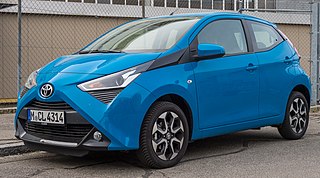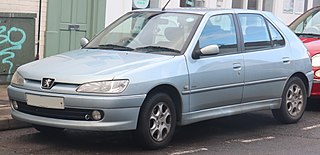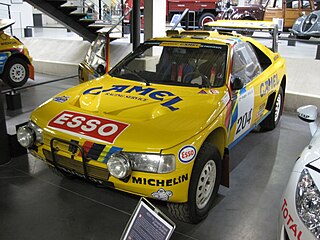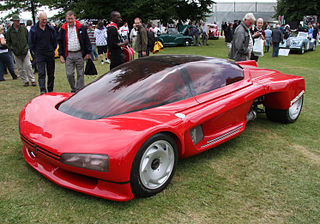
Peugeot is a French brand of automobiles owned by Stellantis. The family business that preceded the current Peugeot companies was founded in 1810, is regarded as the oldest car company in the world. On 20 November 1858, Émile Peugeot applied for the lion trademark. Armand Peugeot (1849–1915) built the company's first car steam tricycle. They joined forces with Léon Serpollet in 1886; this was followed in 1890 by an internal combustion car with a Panhard-Daimler engine.

The Peugeot 406 is a large family car that was produced by French automaker Peugeot between 1995 and 2004. Available in saloon, estate and coupé bodystyles with a choice of petrol or turbodiesel engines, the 406 replaced the Peugeot 405 in Peugeot's lineup, and was itself replaced by the Peugeot 407.

The Peugeot 205 is a supermini (B-segment) car produced by the French manufacturer Peugeot from 1983 to 1999.

The Peugeot 405 is a large family car manufactured by the French automaker Peugeot from 1987 to 1997. Its production continued under license from outside Europe in Iran by Iran Khodro Company until 2020. It was voted European Car of the Year for 1988 by the largest number of votes in the history of the contest. About 2.5 million vehicles have been sold worldwide, both in left and right drive versions, as a saloon and estate. In early 2020, the 33-year production run of the Peugeot 405 was counted as the twentieth most long-lived single generation car in history."

The Ford RS200 is a mid-engined, all-wheel-drive sports car that was produced by Ford Motorsport in Boreham, UK, from 1984 to 1986. The road-going RS200 was the basis for Ford's Group B rally car and was designed to comply with FIA homologation regulations, which required 200 parts kits to be produced and at least one road-legal car to be assembled. It was first displayed to the public at the Belfast Motor Show.

The Citroën BX is a large family car which was produced by the French manufacturer Citroën from 1982 to 1994. In total, 2,315,739 BXs were built during its 12-year history. The hatchback was discontinued in 1993 with the arrival of the Xantia, but the estate continued for another year. The BX was designed to be lightweight, using particularly few body parts, including many made from plastics.

The Aston Martin Bulldog, styled by William Towns, is a British, one-off concept vehicle produced by Aston Martin in 1979. The code name for the project was DP K901. Initially, a production run of 15–25 cars was planned, but the project was deemed too costly and only one was built.

The Peugeot 505 is a large family car produced by the French manufacturer Peugeot from 1978 to 1992 in Sochaux, France. It was also manufactured in various other countries including Argentina, China, Thailand, Indonesia and Nigeria. The 505 was Peugeot's last rear-wheel drive car.

The Talbot Horizon is a compact hatchback that was designed by Chrysler Europe and was produced from 1978 to 1987 under the Simca, Chrysler and Talbot nameplates. The successor to both the Simca 1100 and Hillman Avenger, the Horizon adopted a front-wheel drive, transverse-engine layout.

The Triumph Acclaim is a front-wheel drive compact family saloon/sedan manufactured by British Leyland (BL) from 1981 to 1984. It is a locally built version of the Honda Ballade. It was the final vehicle marketed under the Triumph marque, and the first product of the alliance between BL and Honda which would last until the mid 1990s.

The Peugeot 907 was a concept car built by Peugeot. Unveiled at the 2004 Paris Motor Show, the car was created by styling chief Gérard Welter and designer Jean Christophe Bolle Reddat to celebrate the closure of the firm’s 40-year-old design centre at La Garenne and the opening of the new centre at Vélizy.

Group B was a set of regulations for grand touring (GT) vehicles used in sports car racing and rallying introduced in 1982 by the Fédération Internationale de l'Automobile (FIA). Although permitted to enter a GT class of the World Sportscar Championship alongside the more popular racing prototypes of Group C, Group B are commonly associated with the international rallying scene during 1982 to 1986 in popular culture, when they were the highest class used across rallying, including the World Rally Championship, regional and national championships.

The Toyota Aygo is a city car (A-segment) marketed by Toyota mainly in the European market between 2005 and 2022 across two generations. The Aygo was first displayed at the 2005 Geneva International Motor Show. It was built alongside the related Citroën C1 and Peugeot 107/108 at the Toyota Peugeot Citroën Automobile Czech (TPCA) joint venture in Kolín, Czech Republic. The Aygo's production ended in 2021 and the model was replaced by the crossover-styled Aygo X.

The E25 Turbo concept sports car was built by BMW as a celebration for the 1972 Summer Olympics in Munich. It was designed by Paul Bracq, with gullwing doors and was based on a modified 2002 chassis with a mid-mounted engine. The Turbo featured a 276 hp turbocharged version of the engine from the BMW 2002, foam-filled front and rear sections to absorb impact, side impact beams, a braking distance monitor utilizing radar, and a futuristic cockpit. The car developed 206 kW at 7100 rpm and could reach 100 km/h (62 mph) from a standstill in 6.6 seconds. The top speed was 250 km/h (155 mph).

The Peugeot 306 is a small family car built by the French car manufacturer Peugeot from 1993 to 2002. It replaced the 309. Peugeot gave the 306 many updates and aesthetic changes to keep up with the competition, and it was replaced by the 307 in 2001. Cabriolet and estate versions continued until 2002. Versions were built in Argentina by Sevel from 1996 to 2002.

In automotive design, an M4, or Mid-engine, Four-wheel-drive layout places the internal combustion engine in the middle of the vehicle, between both axles and drives all four road wheels.

The Peugeot 208 is a supermini car produced by the French automaker Peugeot. Unveiled at the Geneva Motor Show in March 2012 and positioned below the larger 308. The 208 replaced the 207 in 2012, and the car is currently at its second generation.

The Peugeot 405 Turbo 16 is a coupé derived from the Peugeot 405 and the Peugeot 205 Turbo 16, built by Peugeot Talbot Sport for African rally raids in 1988. Driven by Ari Vatanen, the four wheel drive car won the Paris Dakar rally in 1989 and 1990. It won the Pikes Peak International Hill Climb in 1988 setting a record-breaking time of 10 minutes and 47 seconds in the hands of Vatanen. Footage from Vatanen's run was used to create the short film Climb Dance.
The Welter-Meunier P82, and its successors and derivatives, including the P83, the P83B, and the P86, are a series of mid-engined Group C sports prototype race cars, designed, developed and built by French racing team Welter Racing, for sports car racing, between 1982 and 1986. The cars best result was a 6th-place finish at the 1982 1000km of Monza, being driven by Roger Dorchy, Guy Fréquelin, and Jean-Daniel Raulet. It was powered by a Garrett twin-turbocharged, 2.7 L (160 cu in), Peugeot PRV, V6 engine, producing between 600–890 hp (450–660 kW) @ 8300 rpm, depending on boost pressure, which drove the rear wheels through a 5-speed manual transmission. The chassis design was constructed into an aluminum monocoque, and the car weighed approximately 900 kg (2,000 lb).

The Peugeot Proxima is a concept car, designed, developed, and built by French manufacturer Peugeot in 1986.























